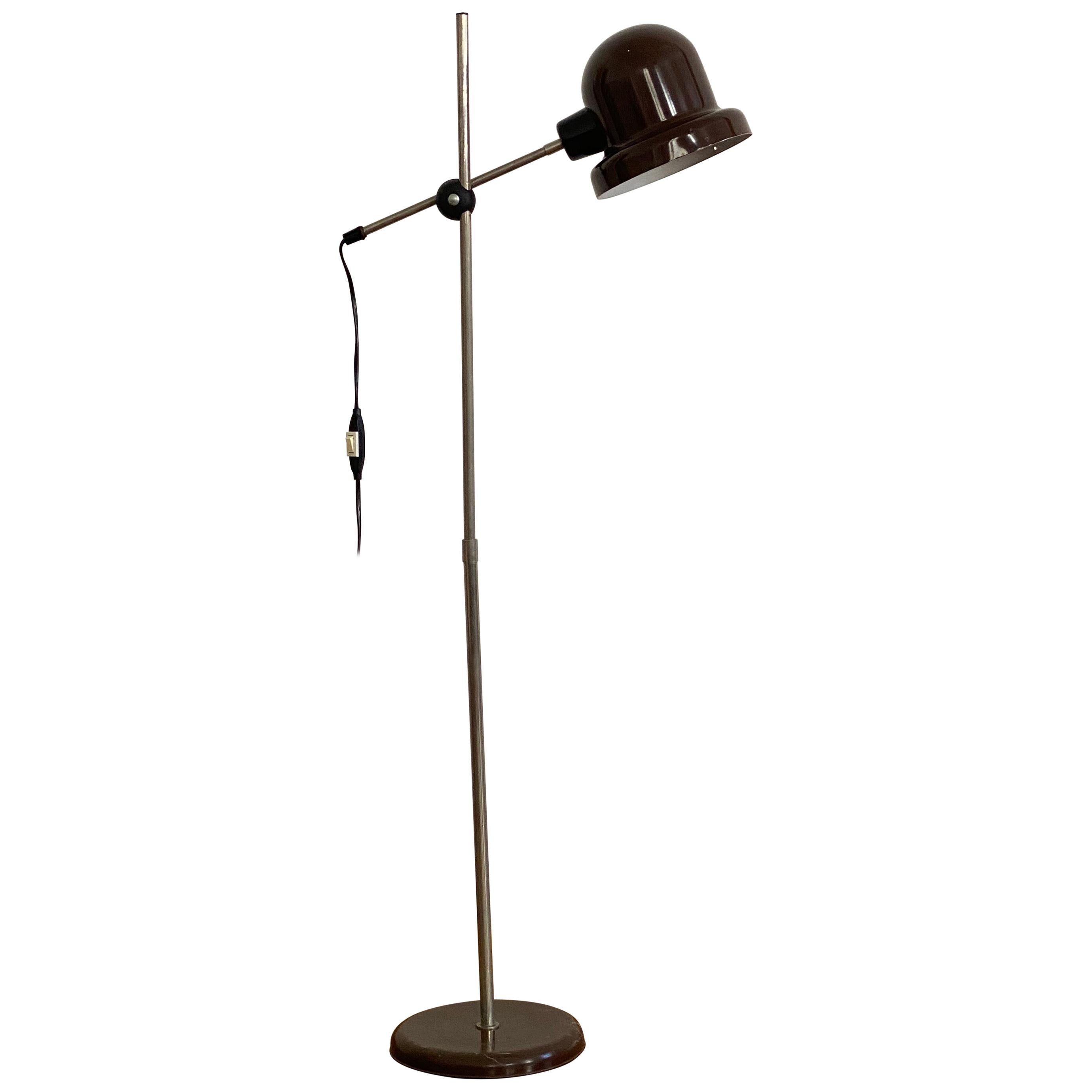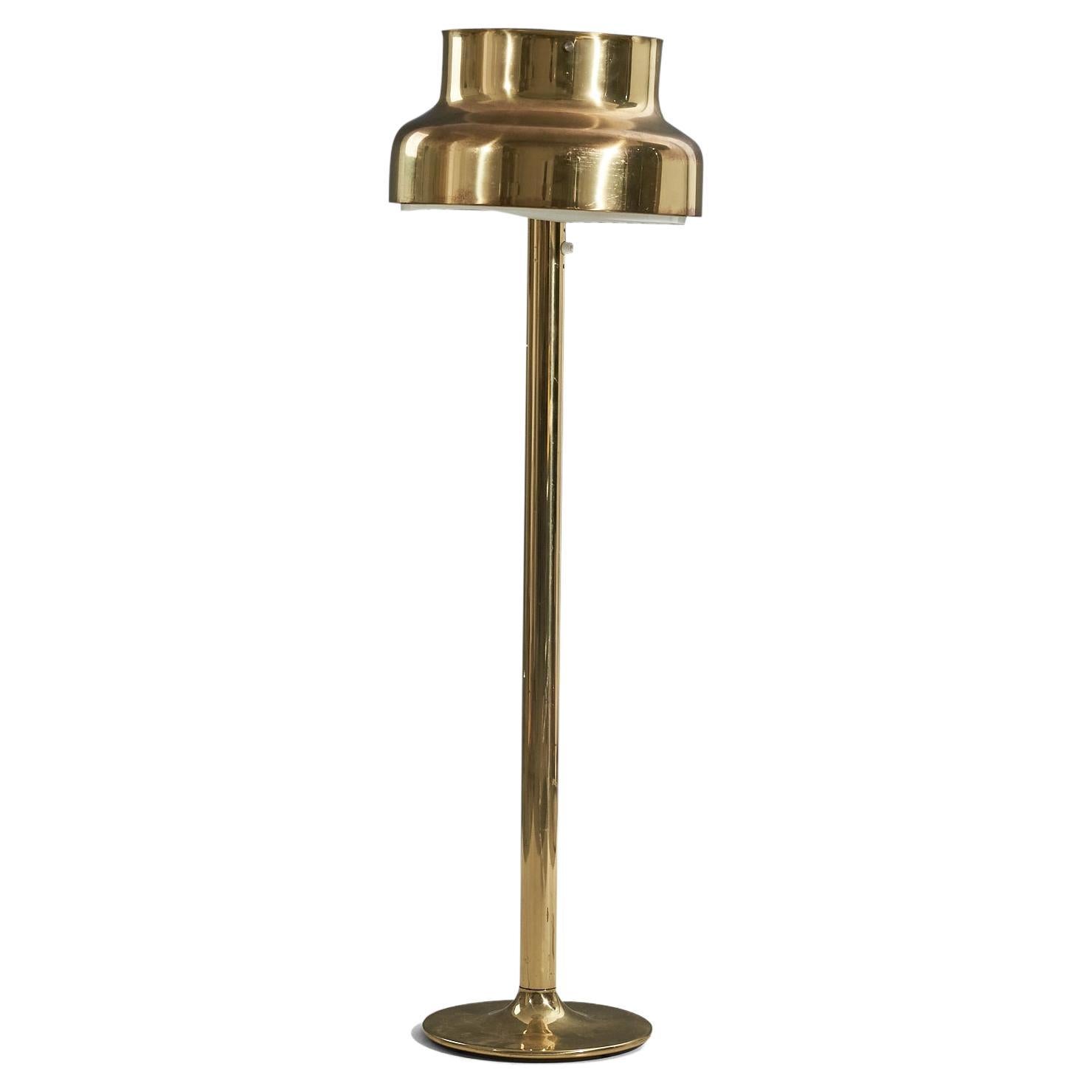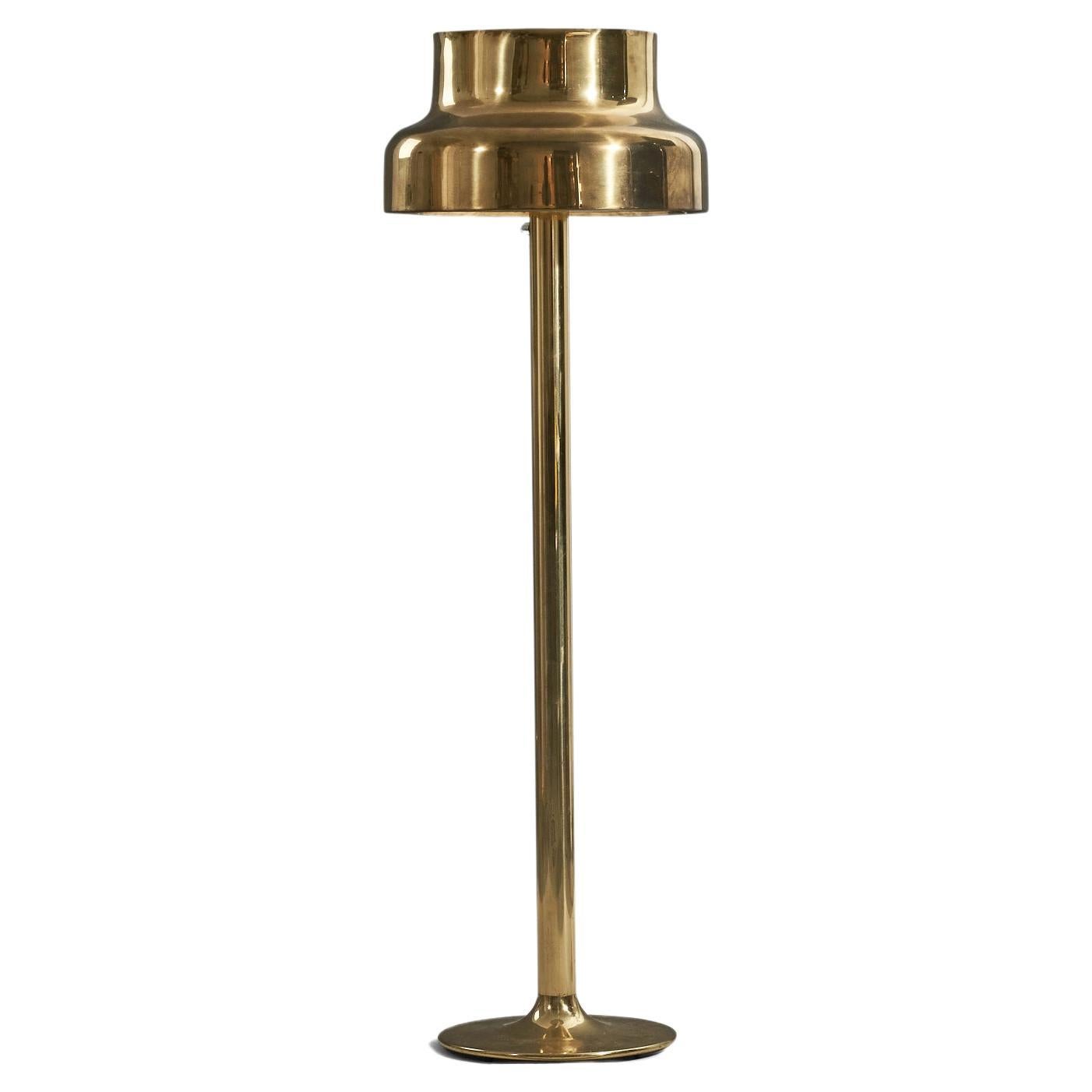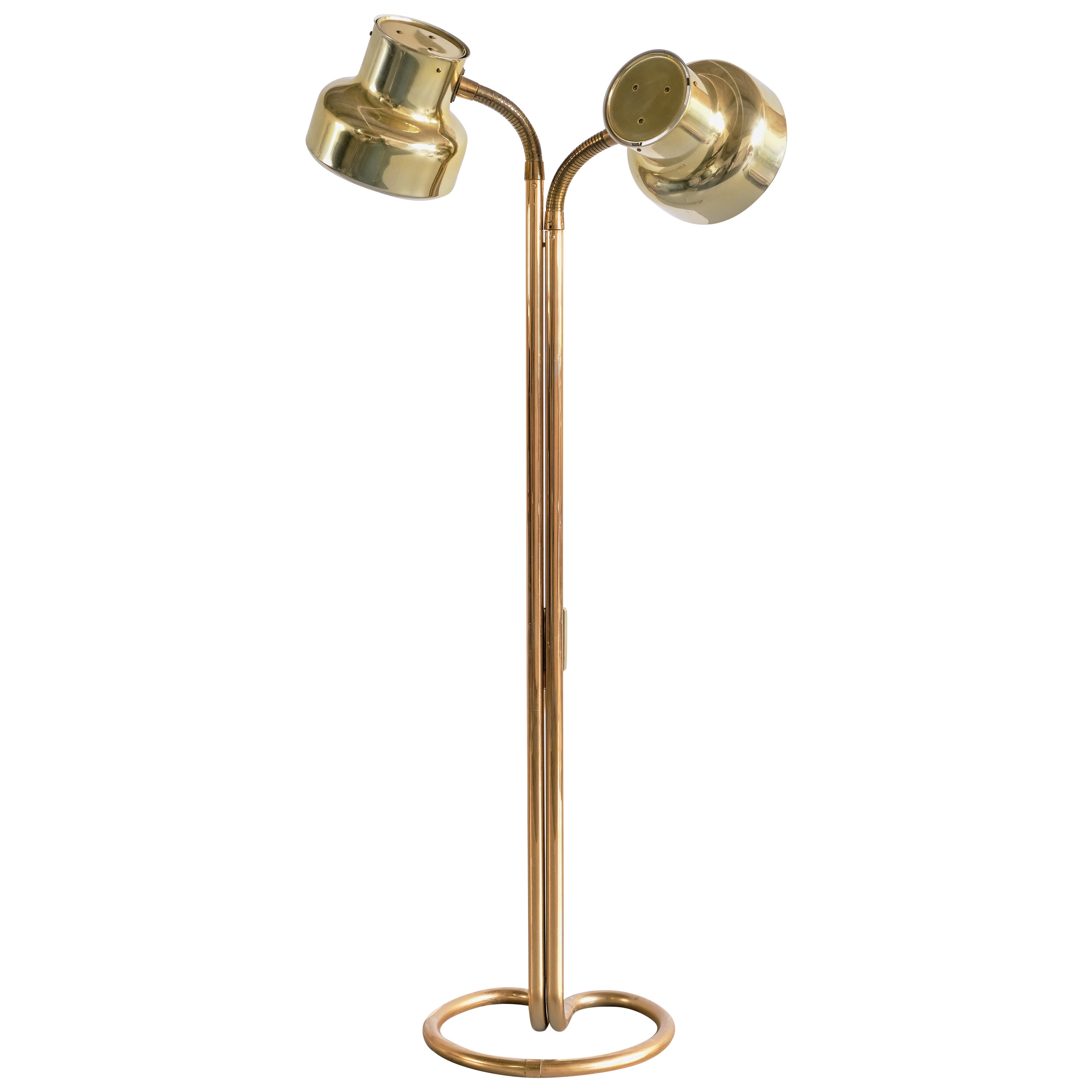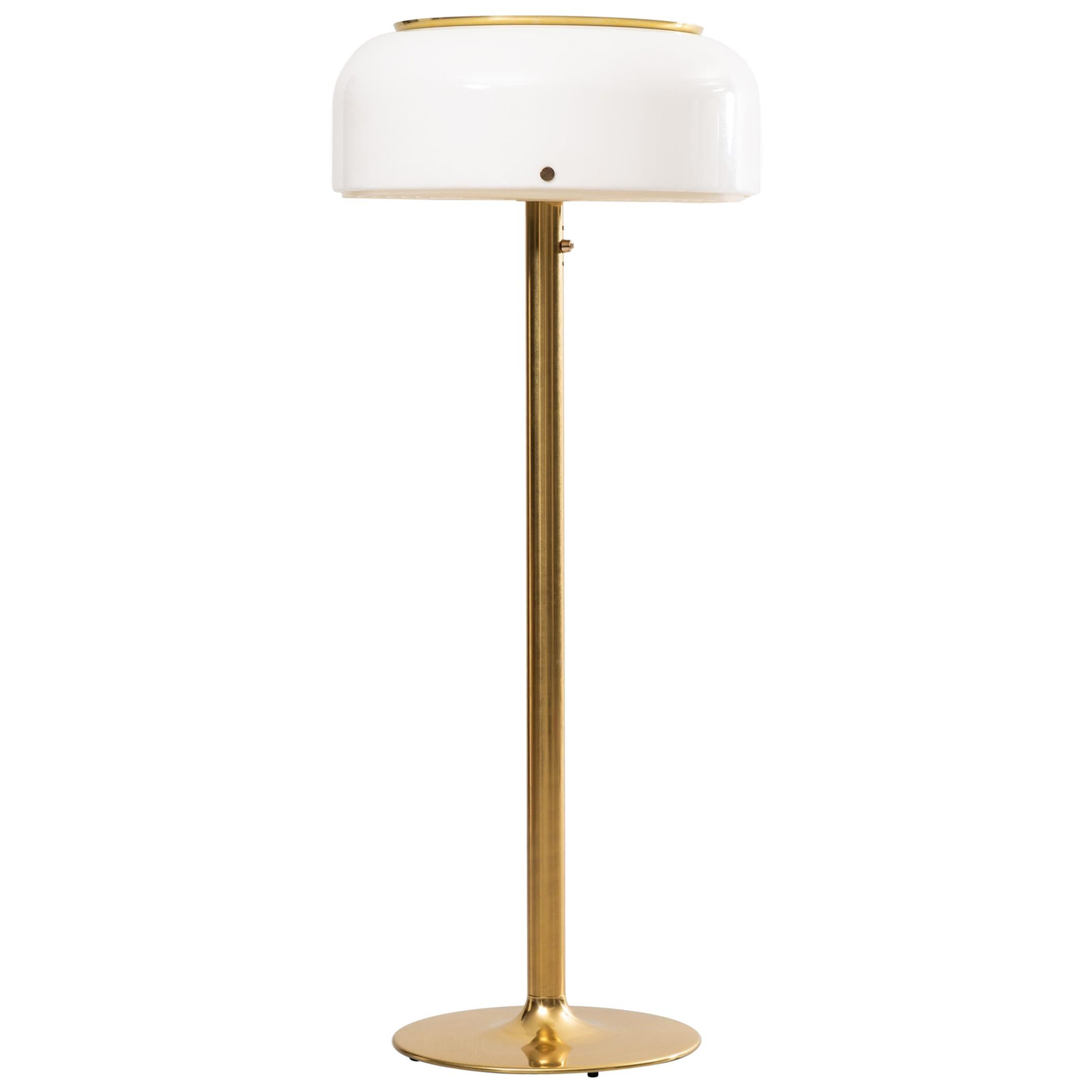Items Similar to Anders Pehrson Ateljé Lyktan SWEDEN set of 5 floor lamps f. Olympia 1972 Munich
Want more images or videos?
Request additional images or videos from the seller
1 of 20
Anders Pehrson Ateljé Lyktan SWEDEN set of 5 floor lamps f. Olympia 1972 Munich
About the Item
Anders Pehrson for Ateljé Lyktan
FLOOR LAMP "OLYMPIA"
set of five floor lamps
recommended with 2 E14 bulbs 25W and 40W as the lamp can be switched in 3 different ways:
left bulb / right bulb / both of them
IMPORTANT NOTE for US customers 110 V / 120 V : nowadays you can find LED E14 bulbs with 110V on Amazon (chose them dimmable as they last longer) so there is no need of a voltage converter any more!
measurements each::
H / height: 106cm ~ B max / max width: 31cm ~ DM Schirm / diameter shade: 19cm
Gew. / weight: 2,7Kg
Swedish designer K. Anders Pehrson was born in Gothenburg in 1912.
He studied engineering in his hometown and began working for Philips as a design manager in 1952.
In 1964, Pehrson became owner, plant manager and artistic director of the lighting manufacturer
Ateljé Lyktan in Åhus.
Pehrson designed the classic Bumling ceiling pendant lamp for Ateljé Lyktan (1968). Bumling, which means "boulder" in Swedish, was first exhibited at a lighting fair in Gothenburg. The bulbous lamp was over half a meter wide and bright green. The lamp was originally produced as a family of six different sizes and a wide range of colors, and became an instant success, both in Sweden and internationally. Demand was so great that Ateljé Lyktan had to subcontract the production of additional lamps. In 1970, after a lighting exhibition in Copenhagen, Pehrson was asked to present a lighting concept for the Olympic Games in Munich. Pehrson developed an interior lighting concept based on the 591 Simris table lamp and the 781 Simris floor lamp (both 1964). In 1972, Ateljé Lyktan supplied 16,300 lamps to the Olympic Village in Munich, which was the largest order in the company's history. In 1974, Pehrson sold Ateljé Lyktan to the Swedish company Fagerhult, but remained general manager, artistic director and sales manager throughout the 1970s.
During his time at Ateljé Lyktan, Pehrson designed many luminaires, including Simris (1964), Rampling (1966), Supertube (1967), Fungus (1969), Crystal (1970), Knubbling (1971), Tube (1973), Sovo (1978) and others. Pehrson deceased in 1982.
- Creator:Anders Pehrson (Designer)
- Dimensions:Height: 41.74 in (106 cm)Width: 7.88 in (20 cm)Depth: 11.82 in (30 cm)
- Sold As:Set of 5
- Power Source:Plug-in
- Voltage:110-150v,220-240v
- Lampshade:Included
- Style:Mid-Century Modern (Of the Period)
- Materials and Techniques:
- Place of Origin:
- Period:
- Date of Manufacture:1968 -1972
- Condition:Wear consistent with age and use.
- Seller Location:Kumhausen, DE
- Reference Number:1stDibs: LU8587235807612
About the Seller
5.0
Gold Seller
These expertly vetted sellers are highly rated and consistently exceed customer expectations.
1stDibs seller since 2023
8 sales on 1stDibs
Typical response time: 2 hours
- ShippingRetrieving quote...Ships From: Bodenkirchen , Germany
- Return PolicyA return for this item may be initiated within 10 days of delivery.
More From This SellerView All
- a pair of 1950s Studio Keramik floor Vases Atelier Berta Huber Roethe LandshutLocated in Kumhausen, DEan amazing set of 2 STUDIO KERAMIK FLOOR VASES by Atelier Herta Huber Roethe Landshut 1950s Manufacturer HUBER ROETHE Design Period 1950 to 1959 Production Period 1950 to 1959 C...Category
Vintage 1950s German Mid-Century Modern Vases
MaterialsPottery
- Karl Nothhelfer very rare SET of 2 Wingback Armchairs & Sofa 1950s solid CherryLocated in Kumhausen, DEjust beautiful SET of Sofa & 2 Wingback Armchairs by Prof. Karl Nothelfer - Designed in 1957 maker: Schörle & Gölz in Stuttgart - Bad Cannstatt solid Cherry Wood new upholstery and fabrics in 1998 according to last owner ( since then just in use for 2 years so upholstery is perfect ! ) Seatrests can be removed - and fixed by clips on belts - high class - measurements: easy chair is 70cm wide ~ sofa is 178cm wide both: seating height 40cm ~ seating depth: 57cm condition - all firm and in very good condition - no damages furniture have fully been accurately cleaned :: - 3 steps: A: air pistol - B: industrial hoover - C: latest Kärcher "wash&hoover" technology - woods have been polished several times note: please ask for shipping quote by sending us your postcode/destination Prof. Karl Nothelfer * 14 June 1900 ~~ + 20 May 1980 Since the beginning of the 15th century, the Nothelfer family of carpenters has been continuously resident in the former town of Überlingen without interruption. Every carpenter at that time mastered all the possibilities of woodworking: so did the Nothelfer. They could carpenter, even carve altars and figures, and set them in gold, silver and paint. (churches in Owingen and Hödingen]. Some family members lived and worked and worked in Hedingen or Hödingen,like today the jubilarian Karl Nothelfer (this in 1975). His father, Karl Anton Nothelfer, as the eldest of seven siblings, was able to take over his father's carpentry business in Überlingen. Karl Anton Nothelfer, the eldest of seven siblings, was unable to take over his father's carpentry business in Überlingen. He instead moved to the industrial town of Singen with his young wife Rosalie, née Hanner, from the from Hohenzollern in 1896 and moved to the former Poststraße and founded his own carpenter's workshop. He had a highsense of quality and form and was already a member of the German Werkbund before 1914. Karl Nothelfer and his three siblings grew up in such air. After attending school and the secondary school in Singen, the young Karl learned the carpenter's trade in his father's workshop then moved on to the Badische Landes-Kunstschule in Karlsruhe, where he studied architecture. At that time the well-known furniture professor also worked there Fritz Spannagel, born in Freiburg in 1891, who settled in 1938 at Ittendorf Castle near Meers- burg (died 1957). In 1928, the gifted young architect received a teaching assignment at the at the Karlsruhe School of Art, but followed his teacher Spannagel to Berlin in the same year. Berlin. Here he worked from 1928-1945 as a teacher - appointed professor in 1931 - at the Berlin Tischler-Schule, the later Bauschule für Raumgestaltung. The furniture he created in Berlin became internationally known through many exhibitions and lectures. nationally known and influential. His furniture creations ushered in a new era in German and a new era in German and European furniture design. At the world exhibition in Paris 1937 Prof. Nothelfer was awarded the Golden Medal for his work in the furniture sector. for his work in the furniture sector. A first summary and balance of his work on furniture is given in his standard work 1942 published standard work "Das Sitzmöbel", the first compendium of its kind in the world. world. In 1950 he published his second work "Furniture". Both books and a series of brochures were published by Verlag Otto Maier, Ravensburg. Karl Nothelfer continued to work intensively on the design of seating furniture in the years after 1945. In 1950 he succeeded in the important invention of the two-legged skid-base chair, which has been orthopedically - anatomically tested thousands of times - has become accepted all over the world today. Even the most distinguished American furniture companies such as Miller or Knoll-International use the skid as the main theme for desks and chairs. At the same time, N. had a groundbreaking in the redesign of German school furniture and seating for industry. industry. He succeeded in adapting his furniture forms, which originated in wood and handicraft, to the modern technical modern technical possibilities of the industry. He thus became the great refor- of schoolroom furnishings. The architect Nothelfer thinks about himself, that he made his main contribution in the field of seating furniture, although this was not was not really his profession. After the war, Prof. Nothelfer, like so many others, had to start all over again. He settled settled in his home town of Lake Constance in Hödingen in 1945 as a freelance architect and was and was involved in all areas of construction in the years after the war. As early as 1935, he had given many the example of American prefabricated buildings and recommended serial house and recommended it at a time when no one in Germany was even thinking about mass production. Now he developed he developed several types of mass-produced houses, which were manufactured in Baiersbronn. of which more than 800 houses were built in France alone (types Paris, Provence, Normandie). were built. At that time [1946], as part of the reparations in Strasbourg, there was an exhibition of houses with Swedish, Danish, and French designs. with Swedish, Danish, Finnish, English and German houses, where the French occupation for which 6 different types were sent from the French occupation zone, the Nothelfer's house type was considered the top of this exhibition. Karl Nothelfer was also involved in the development of chipboard. In 1946, together with others in Munich, he founded the first magazine "Bauen und Wohnen" ("Building and Living") after the war and remained its co-editor for many years. co-editor of this magazine for many years. By presenting his own work, he has here interpreted what the essence of the magazine wanted to be: Building, in order to live in it, in order to live as a human being and humanly in the built. Karl Nothelfer planned his houses furniture ground plan, from the need for living. In 1948 he was appointed honorary senator of the State Building school in Holzminden. Karl Nothelfer did not build much in Singen. The first post-war house was Haus Fahr on the slope of the Hohentwiel (Domäne); the building material came from a demolished log house that a French officer had built for himself on the Schie- nerberg. nerberg. In 1952, he also built the administration building of the aluminum rolling mill in Singen. rolling mills in Singen, with relief and wall painting by C. G. Becker. In Überlingen he built In Überlingen he built, among others, the Buchinger Sanatorium, the Riese+ Hähnel radio house and various reconstructions in the old town: Haus Kitt with the Glockenspiel, the Haus mit dem Bacchus in the Überlingen village, the Dolphin Fountain in Hödingen (1975). Probably the most beautiful Haus Nothelfers, the Haus Himmelheber, stands in Baiersbronn-Tonbach. On the airfield Mengen, Nothhelfer built the casino building with the 30 square meter faience painting Ikarus by C. G. Becker. In 1954 he founded a second office with architect Hans Schwingen in Düsseldorf. Office, which primarily fertilized the housing construction, true to the motto:from the inside to planning from the outside. The Minister of Housing awarded a prize to the best social housing in North Rhine- Westphalia; it was from the Nothelfer+Schwingen studio in Düsseldorf. Also the idea of new idea of home ownership was also promoted by Nothelfer+Schwingen. promoted by Nothelfer+Schwingen. On the occasion of the red jubilee of the law about condominium ownership Nothelfer gave a lecture in Essen in 1961 on condominium ownership in Europe (published as a brochure). published as a brochure]. From Düsseldorf, among many others, in the silk city...Category
Vintage 1950s German Mid-Century Modern Living Room Sets
MaterialsFabric, Cherry
- Italian SET of 2 lady chairs & Sofa & coffee table Duilio Barnabé all originalBy Duilio Dubé BernabeLocated in Kumhausen, DEall pieces in ORIGINAL condition:: Italian 1950s SET consisting of LADY CHAIRS + SOFA SET most probably made by Arflex with its original original covering in amazing good conditi...Category
Vintage 1950s Italian Mid-Century Modern Living Room Sets
MaterialsCarrara Marble, Brass, Iron
- rare huge JASBA "AZTEC" FLOOR VASE marked 1 521 45By JasbaLocated in Kumhausen, DEA very rare 'Aztec' relief-décor floor vase from JASBA KERAMIK. JASBA produced several series of ceramics on themes inspired by ancient civilizations; among the most sought-after t...Category
Vintage 1970s German Mid-Century Modern Vases
MaterialsPottery
- Porcelain Schumann Arzberg Midcentury Classic Floor Vase Cobalt Blue Gold beautyBy Schumann Arzberg 1Located in Kumhausen, DEa real beauty and an absolute rare piece as this is the luxury gilded edition of Schumann Kobalt floor vase range a very elegant Porcelain SCHUMANN Arzberg midcentury Classic Floor...Category
Mid-20th Century German Mid-Century Modern Vases
MaterialsPorcelain
- German Floor Vase 50s 60s huge (50cms) sgrafitto Siershahner FeinsteinzeugfabrikBy Sawa CeramicLocated in Kumhausen, DEFLOOR VASE Siershahner Feinsteinzeugfabrik DEKOR CAPRI 1950s Ritzdekor (sgrafitto) A huge 50s or 60s studio quality 'Klinker' floor vase nr. 54/50 with an sgraffito decor designed ...Category
Vintage 1960s German Mid-Century Modern Vases
MaterialsPottery
You May Also Like
- Floor Lamp by Anders Pehrson for Ateljé LyktanBy Ateljé LyktanLocated in Vienna, ATVintage Bumling floor lamp by Anders Pehrson for Ateljé Lyktan steel lacquered. Nice used condition.Category
Vintage 1960s Swedish Mid-Century Modern Floor Lamps
MaterialsSteel
- Floor Lamp by Anders Pehrson for Ateljé LyktanBy Ateljé LyktanLocated in Vienna, ATVintage Bumling floor lamp by Anders Pehrson for Ateljé Lyktan steel lacquered Nice used condition.Category
Vintage 1960s Swedish Mid-Century Modern Floor Lamps
MaterialsSteel
- Anders Pehrson, Early "Bumling" Floor Lamp, Brass, Ateljé Lyktan, Sweden, 1960sBy Ateljé LyktanLocated in High Point, NCAn early "Bumling" brass floor lamp designed by Anders Pehrson and produced by Atelje Lyktan, Sweden, 1960s.Category
Vintage 1960s Swedish Mid-Century Modern Floor Lamps
MaterialsBrass
- Anders Pehrson, Early "Bumling" Floor Lamp, Brass, Ateljé Lyktan, Sweden, 1960sBy Ateljé LyktanLocated in High Point, NCAn early "Bumling" brass floor lamp designed by Anders Pehrson and produced by Atelje Lyktan, Sweden, 1960s.Category
Vintage 1960s Swedish Mid-Century Modern Floor Lamps
MaterialsBrass
- Anders Pehrson 'Bumling' Floor Lamp in Brass, Atelje Lyktan, Sweden, 1968By Ateljé LyktanLocated in The Hague, NLThis striking floor lamp was designed by Anders Pehrson, the head of design at Atelje Lyktan in Ahus, Sweden. The model is named Bumling and was produced in 1968. It's part of the Bu...Category
Vintage 1960s Swedish Scandinavian Modern Floor Lamps
MaterialsBrass
- Anders Pehrson Floor Lamps Model Knubbling by Ateljé Lyktan in Åhus, SwedenLocated in Limhamn, Skåne länRare pair of floor lamps model Knubbling designed by Anders Pehrson. Produced by Ateljé Lyktan in Åhus, Sweden.Category
Vintage 1960s Swedish Scandinavian Modern Floor Lamps
MaterialsBrass
Recently Viewed
View AllMore Ways To Browse
Triennale Lamp Koch
Vintage Brass Water Pump
Berman Brass Lamp
C Jere Crane
Curtis Jere Barn
Gino Sarfatti 1063
Gino Sarfatti Lamp 1063
Jere Barn
Maitland Smith Torchiere
Naval Searchlight
Pompeii Floor Lamp
Sarfatti 1063
Stilnovo Zagar
Achille and Pier Giacomo Castiglioni On Sale
Bbt Paris
Cedric Hartman Bronze Floor Lamp
George Kovacs Feather Lamp
Kovacs Feather Lamp

